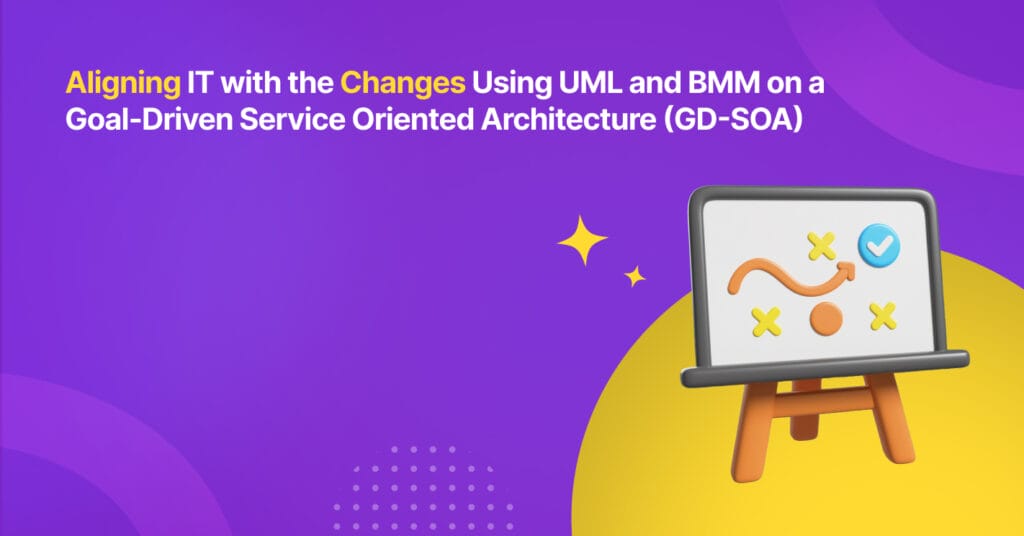Introduction
In today’s dynamic business environment, organisations face the challenge of aligning their IT systems with ever-changing business goals. Rapid advancements, evolving market needs, and shifting customer expectations require IT architectures to adapt seamlessly. Without effective alignment, businesses risk inefficiencies, delayed initiatives, and missed opportunities.
To address this challenge, frameworks like Unified Modelling Language (UML) and the Business Motivation Model (BMM) play a pivotal role in ensuring IT systems remain responsive and goal-aligned. When integrated into a Goal-Driven Service Oriented Architecture (GD-SOA), organisations gain a structured approach to connect IT solutions with strategic objectives, fostering agility and continuous alignment.
What is Goal-Driven Service Oriented Architecture (GD-SOA)?
Service-Oriented Architecture (SOA) is a design principle where systems are built as a collection of loosely coupled services. These modular services provide flexibility and reusability, ensuring systems can adapt to changes without extensive overhauls.
In a Goal-Driven SOA (GD-SOA), the architecture is not just modular but explicitly aligned with business goals. This approach ensures that every IT service directly contributes to achieving defined objectives, creating a seamless connection between strategy and technology.
For example, in a retail enterprise, business goals like “improving customer experience” can drive the implementation of specific IT services such as real-time inventory tracking or automated customer notifications. This alignment ensures the IT architecture continuously adapts to support business priorities.
Understanding the Role of UML and BMM in Business-IT Alignment
Unified Modelling Language (UML)
UML is a standardised modelling language used for visualising, specifying, and documenting systems. By providing clear visual representations of IT systems, UML helps teams identify dependencies, streamline processes, and ensure IT solutions align with evolving requirements.
- Importance in IT Alignment:
UML diagrams such as activity diagrams, use case diagrams, and sequence diagrams clarify complex workflows, enabling IT teams to align services with business priorities effectively.
Business Motivation Model (BMM)
BMM is a framework designed to capture and connect an organisation’s business goals, strategies, and drivers with operational implementation. It provides a structured view of why certain decisions are made and how they influence business actions.
- Importance in IT Alignment:
BMM ensures IT projects remain guided by strategic business motivations, such as customer satisfaction, cost reduction, or innovation. It bridges the gap between high-level business vision and practical IT execution.
The Power of Integration
Combining UML and BMM within a GD-SOA creates a unified approach to business-IT alignment. While BMM defines the “why” (business motivations), UML illustrates the “how” (IT implementation). Together, they enable enterprises to design systems that adapt quickly to business changes while staying goal oriented.
How GD-SOA Combines UML and BMM to Align IT with Change
Implementing GD-SOA using UML and BMM follows a structured approach:
- Define Business Goals and Drivers:
Use BMM to identify the organisation’s key goals, strategies, and external drivers. For example, increasing market share or enhancing operational efficiency.
- Model Systems Using UML:
Develop UML diagrams to visualise the architecture and processes needed to achieve these goals:
Activity Diagrams: Map out workflows to identify process bottlenecks.
Use Case Diagrams: Define interactions between business stakeholders and IT systems.
Sequence Diagrams: Model the sequence of operations between components to ensure alignment.
- Implement in a Modular, Goal-Driven SOA Framework:
Design IT services that directly address defined business goals, ensuring flexibility and reusability.
- Continuous Alignment and Improvement:
Regularly revisit BMM and UML models to assess alignment with evolving strategies and identify areas for refinement.
Benefits of Implementing GD-SOA Using UML and BMM
Adopting GD-SOA with UML and BMM offers tangible benefits:
- Enhanced Business-IT Alignment
IT systems remain continuously aligned with business objectives, enabling faster responses to changes.
- Improved Agility
Modular SOA services ensure IT can adapt quickly to evolving strategies without disrupting existing systems.
- Clarity Through Visual Models
UML provides clear visualisations of workflows and processes, fostering better communication between business and IT stakeholders.
- Collaboration Across Teams
By connecting business motivations (BMM) with system designs (UML), organisations ensure that both technical and non-technical teams remain aligned.
- Strategic Focus
GD-SOA ensures IT initiatives are driven by strategic goals, maximising business value and reducing wasted efforts.
Challenges and Best Practices
While implementing GD-SOA, organisations may face challenges such as stakeholder resistance, lack of technical expertise, or misaligned priorities. Here are best practices to ensure success:
- Stakeholder Involvement: Engage business leaders, IT teams, and architects throughout the process to ensure goals are accurately defined and implemented.
- Regular Review: Continuously revisit BMM and UML models to reflect changes in business priorities.
- Training: Equip teams with the necessary skills to leverage UML and BMM effectively.
- Iterative Approach: Start small, implement modular services, and gradually scale to achieve full alignment.
Conclusion
In a rapidly changing business landscape, aligning IT systems with strategic goals is no longer optional—it’s essential. By leveraging UML and BMM within a Goal-Driven Service Oriented Architecture (GD-SOA), organisations can ensure their IT solutions remain agile, goal-focused, and responsive to change.
UML provides the tools to visualise and model complex processes, while BMM ensures business motivations remain at the heart of IT design. Together, these frameworks empower organisations to bridge the gap between strategy and execution, driving operational excellence and long-term success.
Choose Mitrais
Ready to align your IT systems with business goals using UML, BMM, and GD-SOA? Mitrais is here to help. Our team of experts specialises in designing and implementing Goal-Driven SOA frameworks tailored to your organisation’s needs.
Whether you’re starting your journey or looking to optimise existing processes, Mitrais offers tailored consulting services to help you achieve seamless business-IT alignment.
Contact us today to explore how we can support your IT transformation initiatives.
Visit www.mitrais.com to get started on your path to IT and business alignment.






